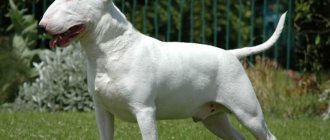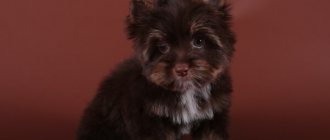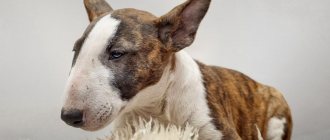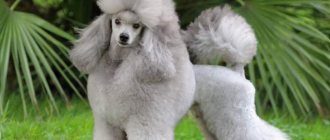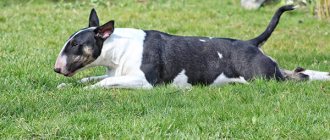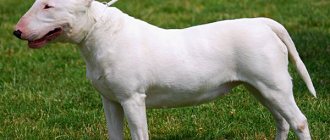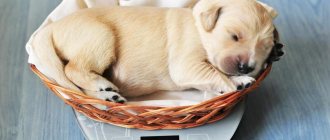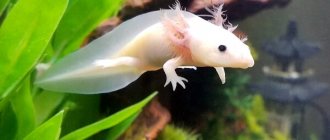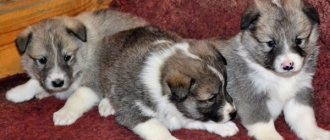The main opinion regarding dog breeds that society classifies as fighting dogs is that they are unbridled aggressors, angry jocks, ready to start a fight with other animals or people at any moment. The same applies to bull terriers. But this opinion is very far from the truth. The owners of these snow-white, robust dogs, and this color is the most common, will immediately note their extraordinary devotion, playfulness, love and a lot of other positive qualities.
In this article we will figure out who the bull terrier really is - a ferocious killer or an excellent companion, how to properly raise such a pet, what to feed and how to properly care for it.
History of the origin of the breed
Bullies, like many terriers, were bred in Great Britain. In distant harsh times, the main entertainment for people was baiting bulls with dogs. English bulldogs took part in such fights. And they coped with their responsibilities well.
In 1835, such cruel entertainment was banned. The search began for new exciting ways to spend time. The most popular were dog fights and rat baiting. English bulldogs, with their short muzzles and high paws, were not suitable for the role of nimble fighter and rat catcher.
Crossing of bulldogs with other breeds began. Terriers turned out to be one of the most promising. They were chosen because of their speed of movement, dexterity and ability to make quick decisions. The resulting dogs, called “Old Bull and Terriers,” were ugly, had crooked legs and a strangely oval shaped skull, but they coped with the duties of fighters perfectly.
The ugliness of the new dogs worried dealer and dog lover James Hinks. He began breeding the breed in 1850, deciding to improve the external qualities of the dogs, but retain the fighting qualities. Out of commercial interest, he decided to breed a snow-white dog, so the Old English Terrier and Dalmatian were brought into the selection.
The first representative of the breed was shown at an exhibition in Birmingham in 1862. This was a completely new type of dog, to which the breeder gave a simple name - Bull Terrier. They turned out to be smart, active, inquisitive and very loyal. At the same time, the force with which the dogs clenched their jaws in a fight was simply phenomenal - almost 25 atmospheres.
Photo: wikimedia.org
The breeders of the original Old Terriers were hostile to the appearance of snow-white bull terriers. They spread the opinion that a beautiful dog cannot be a full-fledged defender and fighter. Hinks offered them a bet: he pitted the bull terrier bitch Puss against an old type bitch. At the same time, Puss was almost 20 pounds lighter than her opponent. The dog fight did not last even half an hour: Puss dealt with her opponent without receiving serious damage.
Basic colors
According to breed standards, the color of the Bull Terrier should be white.
In this case, skin pigmentation does not matter. However, other colors are also acceptable, the owners of which can also participate in exhibitions and win prizes.
White
White is considered the most common and preferred color, with the standard allowing for spots of a different color on the face, head, neck or ears. Even in this case, the color will be considered white.
But, if there are spots on the body or legs, the color will be considered white with markings.
Ginger
Red is considered a color in which the dog is completely covered with red hair. In this case, the shade can be anything, from dark brown to light red.
However, a very light color is considered fawn and is undesirable, as it leads to a decrease in points at shows..
Black
A completely black color in a Bull Terrier is extremely rare; in most cases, such dogs have white spots on their paws, face or neck, but in this case, the color will be considered two-tone.
Two-color (bicolor)
The bi-colored Bull Terrier may have areas of white, and these may be located on the paws, tail, muzzle or chest.
The main condition is that white spots should not occupy more than 50% of the body surface.
Tricolor
This color may include:
- Black.
- Ginger.
- White.
- Brown.
According to the standard, a tricolor dog should have no more than 50% white . Other colors must be clearly distinguishable and can be of any proportion.
brindle
As a rule, in such pets the red color acts as the main color and is complemented by black stripes. At the same time, the standards allow black color as the main color with red stripes.
White markings are also allowed on the entire body except the muzzle . If white spots are present on the face, then the color is considered brindle-white.
Grey
This color is quite rare and, as a rule, is a sign of a non-purebred dog.
Animals of this color are usually not allowed to exhibitions and do not participate in breeding work.
Brown
Brown color is considered one of the variants of red and can have any shades except fawn.
Fawn coloring is considered undesirable and such dogs are not allowed for breeding..
Description of the breed
Note that the bull terrier bred by Hincks did not exist in this form for long. Selection continued, and in 1928 a male was bred, which became the model of the modern bull terrier. It was Lord Gladiator, whose head was already almost close to modern standards and very much resembled an egg.
The new dogs were distinguished by good health and their life expectancy was 11-14 years.
Colors
Initially, breeders bred a white dog, anticipating high interest in it among aristocrats. Subsequently, crossing with Amstaffs occurred, resulting in the first colored bull terriers. Their appearance was met with hostility; opponents protested the decision of the judges of the exhibition, where such a dog won. In their opinion, breeding colored bull terriers was supposed to destroy the breed.
However, the appearance of dogs of other colors saved her, freeing her from diseases that began to appear as a result of the depletion of the gene pool during the selection of snow-white individuals.
Allowed colors:
- white is considered the main color for the breed. Markings are allowed and must be located strictly on the head. There are often bull terriers whose entire body
- covered with dark spots reminiscent of the color of a Dalmatian. Absolutely snow-white dogs are considered albinos;
- brindle – there are frequent black stripes on a red background;
- tri-color - black predominates with a small amount of white and red tan marks. Often this color resembles a Rottweiler or Doberman;
- red color. Currently, more and more individuals are of all shades of red or brown. The dog may be completely red or have white spots located on the chest, paws or face;
- Colors of blue, sand, and gray are considered unacceptable.
Photo: pixabay.com
Standard
- the weight of a bull terrier does not depend on gender and varies between 23-30 kg;
- height at the withers in females can reach 40 cm, in males up to 55 cm;
- The bull terrier's coat is dense, thick and tough;
- the head is shaped like an egg, lowered down;
- the lower jaw has clear outlines;
- erect ears with strong cartilage. It is currently impossible to see a Bull Terrier with cropped ears; this was prohibited back in 1895;
- eyes are one of the distinguishing features of the breed. It is officially recognized that they have a triangular shape. Blue eyes will result in disqualification;
- the teeth are large, strong and very sharp;
- the bite is scissor-shaped; the tail is thick and strong at the base, tapering at the end. Set low;
- the bull terrier's structure is compact, but at the same time harmoniously developed and muscular;
- the nose should have even pigmentation. Pink, sand, or flesh-colored pigments are not acceptable.
Photo: flickr.com
Breed varieties
The FCI identifies breed varieties: Staffordshire, dwarf (mini), English bull terriers.
The Staffordshire is not much like its brother, it is slower.
The mini bull terrier standard provides for all the same requirements that apply to regular bull terriers. But from the name of the breed it becomes clear that the difference between the species lies in their size. In addition, the mini brothers are subject to more stringent weight requirements. The height of a decorative bull terrier should not be more than 35 cm, and its weight should be between 11-15 kg. If such indicators are exceeded, the dog will look awkward, like a beefy, beefy guy with short legs.
Photo: pixabay.com
Similar breeds
We can say that most fighting breed dogs have something in common. Due to its external uniqueness, the Bull Terrier is very difficult to confuse with any other breed.
Pakistani Bull Terrier
Another name for the breed is Gull Terrier. Dogs have many similar traits, being close relatives. But the Pakistani has a smooth and wide head shape, not an egg shape.
In addition, Gull Terriers are taller (up to 68 cm at the withers) and heavier (up to 50 kg).
Otherwise, English and Pakistani bull terriers are almost identical.
Photo: wikimedia.org
Pit bull terrier, american stafford
The most famous fighting dog breeds in our country, mentioned together with bull terriers in scary stories about dog attacks. They are united by enormous energy and power, but not anger and aggression. Only improper upbringing can turn these three into uncontrollable killers.
Photo: wikimedia.org
Types of pets
There are 4 types of the Bull Terrier breed that are allowed by the standards.
This:
- Bulldog.
- Terrier.
- Intermediate type.
- Dalmatian.
Bulldog
Distinctive features are compactness, massiveness, powerful bones, strong neck and wide chest. Such dogs are stockier and stronger, have elastic hips and a powerful body.
This type is quite rude, disproportionate and energetic, and also has a number of disadvantages:
- Short legs.
- Squatness.
- Short neck.
- Raised shoulders.
Terrier
The terrier type is distinguished by precision of lines, compactness and proportionality of the body . Typically, dogs of this type have lighter bones, a short back, straight and rather high limbs.
The disadvantages include:
- Lack of strength and energy.
- The frame is too light for this breed.
- Narrow chest.
- Excessive ease of movement.
Dalmatian
This type is distinguished by a neat and proportional exterior, a long neck and graceful limbs. The head of such pets is very long, but neat, the sides are flat, the muzzle is elongated and the tail is long.
Some representatives resemble a hound, which in no way corresponds to the standards of the bull terrier breed.
Intermediate
Intermediate type dogs took on the qualities of the other three . The head of such pets is proportional and has a slightly elongated shape. The neck is long and strong, the shoulder blades are set correctly, the paws are straight, the chest is wide. The tail is horizontal and low set.
This type of dog is less rough than the bulldog type, but stronger than terriers . At the same time, such a dog is quite compact, well built, but does not have grace.
Character and behavioral characteristics
Let us highlight the main features of the Bull Terrier:
- stubbornness;
- constant desire to dominate;
- congenital zoo aggression;
- does not have genetically inherent aggression towards humans. Puppies that showed aggression towards humans were discarded during selection;
- loves children.
When getting such a dog, you need to understand that the owner must take a dominant position relative to the pet. The relationship between the bull terrier and other animals in the house will be very difficult - he will be dangerous for them if the owner cannot put him in his place. Although in many families several bull terriers coexist, living side by side with cats and domestic rodents.
This is how they can get along with cats.
What do boys and girls look like and how are they different?
Bull Terrier boys are in most cases larger than girls, have stronger bones, and are also much more active and aggressive. They are born fighters and guards. Males of this breed are less tolerant of small children and other animals.
At the same time, bitches are more affectionate and flexible.
Girls look more graceful, have lighter bones and a whiter, more harmonious physique . At the same time, they are inferior to males in strength, speed and aggression. Girls are much more tolerant of children and more often find a common language with pets.
NOTE!
In bull terriers, gender inequality is quite developed, so males are often more devoted to female owners, and females prefer the company of male owners.
Education and training
Raising a bull terrier puppy must be done from the very first days of being in a new home. In addition to accustoming to a nickname, you need to introduce the baby to the inhabitants of the house and the rules established in it. It’s good if children, whom the puppy must obey, take part in the training process.
Watch how the bull plays with the baby.
Particular attention should be paid to the rules of behavior on the street. Often the owner cannot get used to the change in behavior when a calm dog suddenly becomes angry and uncontrollable on the street, and given his size and strength, this can become a huge problem.
It is in relation to the Bull Terrier that we can strongly advise inviting a professional instructor to help or attending training courses.
Long walks and very active games will be very helpful in raising your pet. Be sure to walk your bull terrier before bed so that he can relieve the energy seething in him.
A child cannot walk with a bull terrier. Remember that children will not be able to stop animal fights.
Basic rules for training a small bull terrier:
- teach him to share toys and food;
- if the baby is tired, stop training;
- do not scold for an unfulfilled command, but achieve execution by repetition;
- be sure to encourage during training.
Don’t forget about the obligatory attribute of walks – a muzzle.
It is definitely worth learning how to extinguish conflicts, since even the most balanced representative of the breed can react to the aggressive grin of another dog. To stop the fight, you need to lift the bull terrier's hind legs and fix them between your legs. This way he will have no room for maneuver. Sometimes you may need an object to open your jaw.
If he bares his teeth and growls at another dog, simply restrain him so that the collar is taut.
Photo: flickr.com
Characteristics of bull terriers
In terms of popularity among famous breeds, bull terriers are now in 42nd place. In every country there are lovers of the breed who consider it the best for home keeping. This is a truly unusual dog, difficult to train. She has a memorable appearance and an unusual character. She can become a faithful companion, a cheerful playmate for a child. According to many owners, the Bull is a sissy and a sleepyhead, affectionate, touchy and vulnerable. But the reputation of a dangerous, evil killer did not arise out of nowhere.
The Bull Terrier is not a breed for everyone. He has a complex dominant character. Independence and stubbornness require serious education and timely socialization. Not every dog breeder can handle such a dog. If you raise a Bull Terrier incorrectly, its strength, developed intelligence, fearlessness and endurance, which are inherited from its ancestors, can cause problems.
| Options | Characteristic |
| country of origin | Great Britain |
| time of appearance of the breed | 19th century |
| group of breeds under the ICF classification | terriers, bull terrier section |
| height | 53-55 cm |
| weight | 23-32 kg |
| life expectancy | 11-14 years old |
| purpose of the breed | companion |
| aggressiveness | not aggressive |
| activity | very high |
| intelligence | smart |
| training | complex |
| attitude towards loneliness | can't stand it |
| care | simple |
The advantages of these dogs
According to fanciers, bull terriers are the best pets. They have many advantages in character, behavior and content features:
- friendly, loving, gentle, love children;
- active, hardy, cheerful and playful;
- loyal, ready to protect the owner from any threats;
- smart, quick-witted, easily understands commands;
- due to their small size they get along well in a city apartment;
- require minimal care, are unpretentious and clean.
Minuses
But when getting such a dog, it is important to understand that the bull terrier is an unusual dog. You need to immediately prepare for the fact that others are biased towards the breed. Many people get scared and demand that the dog be muzzled or removed from the dog park. But this is not the only drawback of the breed. Before getting a bull terrier, you need to pay attention to the following disadvantages:
- They become very attached to their owner and cannot stand loneliness;
- prone to dominance, without strict upbringing they become uncontrollable;
- They can make a lot of noise, fuss, chew things out of boredom, are capable of crumbling a chair, tearing off linoleum;
- jealous, do not get along well with pets, can hunt cats, are aggressive towards dogs;
- they require active walks and high physical activity;
- lack guard qualities, since they have no malice towards people;
- They cannot tolerate frost, and white dogs can get burned in the bright sun.
Who can and cannot have dogs of this breed
Bull Terriers are very active, inquisitive and intelligent. The breed is perfect for people who lead an active lifestyle and can spend a lot of time with their pet. Bull Terriers cannot stand loneliness and constantly require attention. The owner must understand the characteristics of this breed and know the rules of training. It is not recommended to have this dog for families who are planning to have a child, as they are jealous and touchy and require a lot of attention. The Bull Terrier will never become a calm and obedient lap dog. The following people should also not have a breed:
- physically weak - girls, pensioners, children;
- hot-tempered, unbalanced;
- unable to gain authority or show firmness;
- for beginners who do not understand how to behave with such a difficult dog to train.
Often professional breeders meticulously choose a new owner for puppies. They try to prevent the dog from developing fighting qualities, so that improper training turns it into an uncontrollable, angry dog. Interesting video about the advantages and disadvantages of bull terriers:
Diseases
Like all dog breeds, bull terriers are prone to a number of diseases:
- deafness;
- acrodermatitis. Characterized by flat legs turned forward. Develops due to a lack of zinc in the body;
- renal failure;
- dislocation of the kneecap;
- heart diseases;
- dislocation of the lens, that is, its free movement in the pupil;
- various types of allergic reactions. The most common reactions are to chicken meat and insect bites, water and vegetation of water bodies;
- sunburn.
The length and quality of your pet’s life will directly depend on your attentiveness. At the first sign of discomfort, consult a specialist.
Advantages and disadvantages
Cheerful disposition, courage, developed intelligence are the undeniable advantages of pets. The peculiarity of the breed is its cleanliness.
Disadvantages of Bull Terriers:
- Hereditary ear problem. A common disease is deafness.
- If there is insufficient education, they will hunt small animals.
- Due to the habit of gnawing, everything can ruin the property in the house.
- They love to dominate.
- They cannot tolerate cold climates due to their short fur. If a Bull Terrier is left in the sun, burns will form on its skin.
- The owner needs to devote a lot of time to training, games and exercises, as dogs do not tolerate loneliness well.
Pregnancy
Puppies appear 9 weeks after mating. During pregnancy, it is necessary to review the feeding diet of the bull terrier bitch. She will need more calcium than usual. Recommendations for increasing the dose should be made by a veterinarian.
After the first signs of pregnancy appear: swollen nipples, drooping abdomen, you will need to reduce the time you spend outside, but make such trips more frequent.
You need to feed your dog more often during pregnancy. Give her more peace, find a secluded place where there are no loud noises. Before giving birth, the bitch tears out the hair around her nipples. The owner needs to take care of their hygiene by wiping them with a clean soft cloth.
If you have experience, you can prepare to give birth yourself. Otherwise, contact a specialist so as not to lose the bitch and her offspring during childbirth.
Price
Bull Terrier puppies (without documents) are sold at a price of 15-20 thousand rubles. If you decide to purchase a dog from a private breeder, we recommend that you read reviews about him on the Internet in advance. He will not provide you with a health guarantee, however, you have the right to demand a dog passport. In it you will find information about the vaccinations that the doctor gave him. The puppy must be vaccinated, especially if he will live on the street.
Puppies taken from nurseries will cost you more (from 25 thousand rubles). The price of a miniature bull terrier is higher, from 35 thousand rubles. When you start getting to know the dog, be sure to analyze him according to 2 parameters:
- Exterior. The dog must be well built and strong. A sign of a bad puppy is lethargy.
- Curiosity. A good watchman must be interested in objects that are in his field of vision. The classic trick is to shake the keys in front of him. If the animal does not show interest, then you should not buy it.
When you buy a puppy, try to surround him with care and attention.
Care
Bull Terriers are unassuming dogs. They will not require special care. Naturally, periodic treatments against parasites and annual vaccinations are necessary.
A dog's ears and eyes need hygiene. It is better to use special lotions sold in pet stores. Teeth should be brushed once every two days using an attachment or a special brush and paste. Monitor for stones and bleeding.
The wool is combed out every few days using a mitten or brush. There is no need to bathe a Bull Terrier often; this is done only when it gets dirty. But considering that these dogs simply love to wallow in various bodies of water during the warm season, they have to do this more often than we would like. For snow-white pets, it is better to use a special shampoo.
Pay special attention to walks in the warm season. Treat your dog against flying insects; even a simple mosquito bite can cause severe hives and swelling.
Photo: pixabay.com
Possible diseases and methods of treating them
Bull Terriers have one genetic feature - poor hearing. Some are even born deaf in one ear. Such individuals are usually discarded. However, a bull terrier who is deaf in one ear can make a good companion.
These dogs also often suffer from kidney problems. In this case, they begin to eat poorly, act distant and often whine. If these symptoms are present, the dog should be immediately shown to a veterinarian.
And some representatives of the bull terrier breed suffer from glaucoma. In this case, they cannot focus their gaze on any object due to severe pain in the eye area. Bull terriers, whose fur has a white tint, often suffer from skin ailments.
Choice of clothes
The Bull Terrier is not suitable for outdoor living. He freezes in the cold and overheats in the heat, often getting sunburned.
You will need specialized clothing selected for the season. It is better to have two or three sets: winter, autumn insulated and waterproof thin overalls.
These dogs simply love to chew and tear everything they can find in your home. Additionally, buy a whole arsenal of toys and tasty bones that will clean your teeth and help pass the time.
Character traits
It is not for nothing that Bull Terriers are called the gladiators of the canine world - they are a strong, hardy and agile animal, distinguished by their unique beauty.
The modern dog of this breed is calm, balanced, devoted to his owners and affectionate towards them.
At the same time, this strong, brave animal is quite capable of protecting the owner or his property in the event of a real threat.
These dogs have a lively and cheerful disposition, they love exercise and love to play with children..
Neither aggression nor cowardice are characteristic of white bull terriers and, according to the standard, are considered a breeding defect.
At the same time, the Bull Terrier is not a dog whose education and socialization could be neglected.
Indeed, in the absence of training and proper upbringing, a dog of this breed can grow up stubborn, willful, fearful and at the same time aggressive towards other dogs and people.
Feeding
The feeding diet should consist of ready-made dry food or natural food. You should not mix the two directions; the digestion of bull terriers reacts very sharply to such changes.
When choosing ready-made food, you need to focus on the premium class, taking into account the diseases and age of the pet.
When creating a natural diet, consult your veterinarian for advice on choosing a vitamin complex.
Natural nutrition should contain:
- raw meat, always lean;
- eggs (preferably quail);
- olive oil (1 tsp every day);
- beef by-products, trimmings;
- cereals – preferably rice and buckwheat;
- low fat fermented milk products;
- vegetables.
Eliminate from your diet:
- river fish;
- smoked and sweet;
- high fat meat;
- hot, salty, spices;
- bakery products.
Here is an example of a holiday lunch.
External breed standards and photographs of the Bull Terrier
Miniature Bull Terrier (dwarf): description of the breed
The standard of the breed is the standard white bull terrier. There is also a variety of miniature dog, the height of which at the withers does not exceed 30 cm. Among dog lovers, it is customary to distinguish the French branch of the fighting breed.
Important! The coat color can be white, brindle, red, and a black bull terrier is rare. There are no individuals with just one shade of color; there are always spots of a different color on the body.
Tricolor bull
English
Description of the Bull Terrier breed is included in the register of the International Canine Federation. This is a strong dog with a harmonious muscular build, a large chest, and an egg-shaped head without brow ridges. The eyes are triangular, elongated, brown, there is a hump on the bridge of the nose, and the ears are erect. The height of the dog at the withers is 55 cm, weight is 25-35 kg.
French
The Bull Terrier is also called the French Bulldog. The breed received this nickname because of its powerful, stocky body and the stubbornness inherent in bull terriers.
Initially, the species was used for dog fighting in the same way as the bull terrier; their behavior characteristics are similar, because the breed contains the blood of the English bulldog. The animals then gained popularity in home keeping as companions. This is a small dog with a flattened muzzle, a powerful body and a wide chest. Male height at the withers is up to 35 cm, weight up to 5 kg.
Tips for choosing puppies
Almost two hundred years of selection was aimed at breeding individuals whose blood will no longer have aggression towards humans, and whose psyche will be stable. Therefore, both in the past and now, it is worth choosing a puppy only in reputable nurseries.
The optimal age for purchase is 2.5-3 months. At this age it is best to begin socializing the baby. When choosing, pay attention to the hearing of the small bull terrier. It is tested, for example, with a squeaking toy.
Consider the parents; even a layman can notice deviations from the standard in such a breed.
Price and where to buy a puppy
The price for puppies ranges from 35 to 90 thousand rubles. Everything will depend on the reputation of the nursery, the pedigree of the parents and the prospects of the puppy. Please note that the pedigree was issued by the RKF.
Choosing a nickname
| For girls | Bessie, Zoe, Mickey, Ronnie, Denna, Devi, Abby, Chloe, Hallie, Zena. |
| For boys | White, Baron, Graham, Tucker, Dustin, Khaki, Cody, Rocky, Zeus, Yarmak. |
Appearance of puppies
Bull Terrier puppies in appearance resemble dense lumps, similar to soft toys. They have a strong build, proportional body parts and a silky coat. Only as she grows up will she become tougher and rougher.
Healthy puppies of this breed are cheerful, active and very entertaining, they get along well with each other, are very playful and affectionate.
Such kids especially need love and attention; this is the only way they can develop a healthy psyche. You should also take into account the characteristics of the breed and start socializing them as early as possible to avoid problems in the future.
Owner reviews
Irina K.
My husband got a bull terrier, he was like a little white cloud. Affectionate and sweet beyond belief. He grew into a wayward impudent man who didn’t give a damn about commands and rules. We suffered a little, then a couple of conflicts happened in the yard: I got into a fight with a dog, almost killed a cat. I had to take courses. I went with my husband. It was very difficult, difficult. It seems that everything has passed, all the problems are behind us. Now she is a smart and affectionate dog, an excellent guard. He only snores loudly, but he knows how to smile)
Vyacheslav S.
I’ll say right away that the dog is very serious. Before that, I had an American Stafford for 13 years. I think this is a less stubborn dog. Bull Terriers are like children all their lives, they always play and jump. Constantly checks for authority. Well, they are noble pigs. Any puddle is their favorite pastime. I thought he would fight with me and he doesn’t know how, he never aggressively. After the first fight, which was not provoked by him, the first one goes to attack any animal. I learned to restrain and separate. This will be difficult for a woman or child.
Life expectancy and what diseases are they susceptible to?
On average, pets of this breed live 12-13 years.
At the same time, white bull terriers may be predisposed to a number of health problems, including such as:
- Congenital deafness.
- Demodecosis.
- Solar dermatitis.
- Mitral dysplasia.
- Lethal acrodermatitis.
- Osteochondrodysplasia.
- Aortic stenosis.
- Inflammatory diseases of the nose, for example, folliculitis or furunculosis.
- Klein-Waardenburg syndrome
- Congenital dislocation of the elbow.
- Osteochonditis of the hock joint.
- Mastocytoma.
- Shortening of the palpebral fissure.
- Eversion and inversion of the eyelids.
- Prolapse of the third eyelid.
- Kidney diseases.
White bull terriers are considered predisposed to hearing problems; they are more likely than other representatives of this breed to have congenital deafness.
Photo
Photo: wikimedia.org
Photo: wikimedia.org
Photo: wikimedia.org
Photo: needpix.com
Photo: flickr.com
Photo: flickr.com
Photo: flickr.com
Photo: flickr.com
Defects and vices of the breed
Physical defects include a body that is too long, too tall or too short, and floppy ears. If the color is tricolor, the white shade should not be more than 50%. Dogs with blue eyes and pink noses are rejected from breeding; blue and liver colors are also considered out of breed.
Giant Schnauzer (dog): characteristics of the breed
Excessive anger and fearfulness in puppyhood are also disqualifying factors. A strong psyche is the main condition for raising an obedient pet
Note! Large dark spots on the skin of a white dog are considered a defect.
Psychological picture
The character of the Bull Terrier is complex. True, pets are far from the fame attributed to them as bloodthirsty killers. But in the wrong hands, a hardy, intelligent bull terrier with a death grip will become a merciless melee weapon.
The dog's behavior depends on its upbringing. With a caring, loving owner, an English Bull Terrier grows up to be open, friendly, and welcoming to strangers. And a nervous, weak, irritable owner will turn into an angry, uncontrollable animal.
Bull Terrier puppies need affection and warmth. Even adult dogs have a hard time withstanding loneliness, but little ones don’t like to be left alone. They need to be surrounded with love and care - then they will grow up obedient and good-natured.
English Bull Terriers have pros and cons. They are loyal, charismatic dogs with a strong character. But the same strong-willed owner can cope with them.
The description of the breed suggests jealousy and stubbornness, which English Bulls inherited from terriers. Dogs are reluctant to share toys and bowls, and compete for the owner’s attention with children and adult family members. Because of these qualities, food, dominance, possessive and play aggression often develops. Any anger is nipped in the bud.
The English Bull Terrier is a one-owner dog. Only one person is involved in his upbringing. If a new family member appears at home, the dog will not obey him either in a month or in 5 years.
Training bull terriers is not easy. Dogs are smart, but capricious and easily distracted. You will have to be patient and put up with repeated repetitions of the simplest commands.
For their fighting past, endurance and strength, bull terriers are called “gladiators”. And light-colored dogs are “white gentlemen” for their refined manners and ability to understand people.
Temperament is highly dependent on genetics. Previously, the breed was bred uncontrollably, which did not have the best effect on its character. Today the situation has changed - sick, psychologically unbalanced animals are not used for mating, and puppies that do not meet the standard are strictly culled.
Only 10% of English Bull Terriers are dangerous to people, and that is due to improper training. It is worth remembering that a puppy is plasticine, and its behavior depends 99% on its owner.
How to choose a puppy
Before adopting a dog, you need to learn everything about bull terriers. The variety requires long walks and tough training. The person must be willing to work with this breed.
Newborn puppies
The puppy is purchased from registered nurseries or from trusted breeders. Only parents with documents can produce high-quality offspring. When meeting the offspring, you should watch how the babies behave. An active and well-fed puppy will grow into a friendly, cheerful dog. It is better to buy a pet at the age of 2.5 months, the young dog is no longer attached to its mother, is not afraid to explore the world, and has passed the necessary vaccinations.
Is it worth getting such a pet?
People who do not have time should not get a Bull Terrier, as the dog requires long, active walks. Characteristics of the Bull Terrier breed require a serious approach to training and socialization of the dog.
Note! The breed should be owned by a person who is capable of long-term training of a pet.
The animal must understand that a person must be obeyed. In the wrong hands, a dog can turn into a dangerous, aggressive beast. Therefore, beginners and people with mental illness are also not recommended to choose this breed as a pet.
If a family lives in a private home and already has experience raising dogs, a bull terrier is suitable for protecting the territory; the puppy will quickly get used to the new home and establish contacts with other pets. There the dog will have somewhere to frolic, and a powerful jaw with a set of strong teeth will scare away uninvited guests.
The bull terrier finds its lovers among breeders. A mischievous, active dog will be a faithful friend in a family with children and will not cause any trouble in caring for its coat. But the dog’s stubborn character and fighting genes require strict discipline during training. Only a person who can cope with the pet’s difficult temperament should own a pet.
Care and maintenance of an adult dog
The Bull does not have a dense, thick undercoat to protect against the cold. Therefore, the dog is not suitable for kennel keeping and can only live in a house.
Caring for a dog of this breed comes down to proper feeding, basic hygiene procedures and regular walking.
The right diet
An adult bull terrier can eat both dry and natural food. In the first case, preference is given to premium or super-premium products that do not contain wheat, corn, soy, dyes, preservatives and other dubious components.
The daily intake is calculated from the table on the food packaging and divided by the number of meals.
The following brands are best suited for bull terriers:
- Royal Canin;
- Brit Care;
- Probalance.
When feeding a bull with natural food, it is important that the basis of the dog’s menu is lean meat, previously scalded with boiling water. Twice a week it is replaced with sea fish or beef offal.
Also included in the bull terrier’s diet is:
- porridge (rice, buckwheat or oatmeal);
- vegetables (pumpkin, carrots and zucchini);
- fermented milk products (yogurt, kefir and cottage cheese);
- eggs.
Bull Terriers are not given long bones, sweets, pastries, chocolate, potatoes or any food from the owner's plate.
Walking and physical activity
The Bull Terrier is an active dog that needs regular walking. The duration of walks with such a dog should be at least 1.5-2 hours a day. In order for the bull to splash out the accumulated energy, the dog must be given the opportunity to run without a leash.
True, it can only be released in specially designated places where there are no people or dogs. Although a properly raised bull is not at all malicious towards others, the dog is only driven along busy streets on a leash and muzzle.
On a note. Since the Bull Terrier is a short-haired dog, for walking in frosty or damp weather he needs clothing that protects him from the cold and does not hinder his movements.
Training and education
You need to raise a dog of this breed from the first days of its appearance in the house. From puppyhood, a dog must know the boundaries of what is permitted and obey the rules established by its owners. The upbringing of a bull terrier should be consistent.
Ideally, all family members should adhere to the same line of behavior with the dog and not allow it to do what others prohibit.
Puppies get tired quickly and cannot concentrate for long. To prevent the dog from getting tired of classes, the first lessons should not last longer than 5-10 minutes.
Bull Terrier training is carried out in a calm environment. Classes start with the simplest, gradually increasing the complexity of the task.
Raising and training a bull terrier takes a lot of time and requires unlimited patience from the owner. An important stage of the educational process is socialization.
A bull terrier bred for dog fighting poses a threat to other dogs. Therefore, immediately after the end of the post-vaccination quarantine, the puppy is taught to calmly treat various irritants.
Care and hygiene
The Bull's short coat is brushed regularly using a grooming glove. During the molting period, the procedure is carried out daily, the rest of the time - a couple of times a week.
They bathe the boule with shampoo no more than 2-3 times a year. After a walk, be sure to wipe the dog’s paws.
The bull's eyes and ears are systematically wiped with a damp cotton swab and inspected for the presence of unusual discharge.
The dog's teeth are brushed weekly with a special paste that does not foam. To prevent plaque and tartar, the boule is given large beef bones and chewy treats.
The dog's claws get worn down while walking on the asphalt. But if necessary, they are shortened with a nail cutter.
Optimal nutrition
To create a balanced diet, it is recommended to consult a doctor. If you are going to feed your dog dry food, it should be a premium product. Do not mix natural food and dry granules. This will cause intestinal diseases.
Natural feeding should include beef, offal, vegetables, eggs, cottage cheese, kefir, and sea fish. The share of meat products makes up at least half of the diet.
Important! It is strictly forbidden to give chocolate, pastries, or pickles.
An adult dog is fed 2 times a day; water should always be freely available. In winter, food should be higher in calories for better thermoregulation of the pet's body.
Attitude towards children
A bull terrier and children can live peacefully in the same house, provided that there is a clear hierarchy in the family and the dog understands that the child occupies the highest level. In this case, the dog will become an excellent playmate and will calmly endure all the pranks.
However, the child must understand that a dog is not a toy and should not be teased or offended.
On a note. Even a well-mannered bull is capable of unintentionally harming a child. Having played too much, the dog may not calculate the grip. Therefore, owners should ensure that the bull terrier and the child are never left alone.
Why is the Bull Terrier considered the most dangerous dog?
The fault for the breed's controversial reputation lies with the breeders. Trying to make money by selling fashionable dogs with unusual appearance, many of them did not care at all about the character of the animals.
They crossed breeders uncontrollably and did not select for such qualities as having a stable psyche and lack of aggression.
The real danger to others is not the real boule, but the mestizo. Such a dog does not correspond to the basic characteristics of the breed, even if outwardly it does not differ from a purebred animal. Therefore, before buying a dog of this breed, it is important to find out its origin.
Ordinary owners are also to blame for the nickname “killer dog” being attached to bulls. Some of them used dogs for other purposes and deliberately developed anger towards people in them.
An aggressive bull terrier, having tasted the fight, becomes unpredictable. The dog strives to re-enter the fight in order to once again experience the feeling of victory.
Such a dog is very dangerous for humans and other animals.
On a note. The force of compression of the boule's jaws is about 25 atmospheres. Therefore, it is extremely difficult to open them. If the bull has grabbed the victim, you can open the dog's mouth by bringing a broken ampoule of ammonia to the muzzle, or using a stick used as a lever.
Mating
English bull terriers take a long time to mature. The first heat in female dogs does not occur until a year later, sometimes at 14-15 months.
Dogs are untied from 2-3 years old. The meeting is held on the dog’s territory – there he feels confident. Before the “date,” the animals are not fed, they are introduced during a walk and given half an hour to an hour to get used to each other.
Pregnancy lasts 56-72 days. 5-7 pups are born in a litter.
Application
The English Bull Terrier is primarily a companion. Difficult, with a complex character and his own opinion. But these qualities make them the favorites of thousands of people who believe that service dogs, with their easy-going nature, lack personality.
English bull terriers are suitable for active people who are ready to spend most of the day with their pets. The dogs are active, active and athletic. They need someone who will appreciate their temperament, who can love endlessly and judge fairly.
Representatives of the breed are good watchmen and security guards. The blood of fighting dogs still flows in their veins.
Bull Terriers are always ready for a fight, although they do not seek it. But in case of danger, even suspicious, they frantically defend themselves and their owner.
Due to the risk of developing aggression, they prefer not to train English bull terriers for protective guard duty. Let the pets remain as loving and friendly as possible for the breed.
Even the most affectionate boule is conflicted. But not everyone can control a dog trained for protection. In this case, while walking you will have to become a psychic owl - turn your head in all directions every second in search of potentially dangerous situations, predict them, avoid people and dogs.
In which countries is the breed prohibited for breeding?
In connection with incidents involving fighting dogs, some countries have introduced an official ban on the breeding and keeping of certain breeds.
Bull Terrier is prohibited:
- in Germany;
- Switzerland;
- Israel;
- Ireland;
- Spain;
- in some states of America.
In the Russian Federation, the Bull Terrier is not prohibited for breeding. But owners of dogs of this breed need to adhere to the existing rules for keeping and walking dogs.
How to care for your fur
The bull terrier's fur is short and very prickly and, when it gets on things, it often remains on them even after washing, because it gets right into the fabric like a needle.
However, they have little fur, so the problem can be easily solved by a vacuum cleaner or regular brushing once a week. It is also useful to brush your teeth with a special brush.
